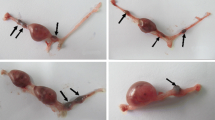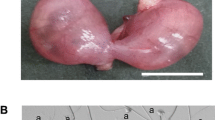Abstract
The DDK inbred strain of mouse has a striking particularity: when DDK females are crossed to males of other strains they exhibit a reduced fertility, whereas the reciprocal crosses (non-DDK females x DDK males) are fertile (Wakasugi et al. 1967; Wakasugi 1973). The low fertility results from an early embryonic lethality, the F1 embryos dying near the late morula-early blastocyst stage. Genetic analyses (Wakasugi 1974) and nuclear and cytoplasmic transfers (Renard and Babinet 1986; Babinet et al. 1990; Mann 1986), have shown that the failure of the embryos to develop is due to an incompatibility between a DDK maternally encoded cytoplasmic product and the non-DDK paternal genome. In order to elucidate the genetic determinism of this embryonic lethality, we have analyzed the fertility of male progeny from a backcross BALB/c females x (BALB/c x DDK)F1 males and that of males from a set of recombinant inbred (RI) strains, established from DDK and BALB/c progenitors, when mated with DDK females. Our results indicate that a single locus, Om, is responsible for the DDK syndrome and is located on Chromosome (Chr) 11, very close to the Sigje locus.
Similar content being viewed by others
References
Babinet, C., Richoux, V., Guénet, J-L., and Renard, J-P.: The DDK inbred strain as a model for the study of interactions between parental genomes and egg cytoplasm in mouse preimplantation development. Development (Suppl), 81–87, 1990.
Bailey, D.W.: Recombinant-inbred strains, an aid to finding identity, linkage, and function of histocompatibility and other genes. Transplantation 11: 325–327, 1971.
Beechey, C.V., Cattanach, B.M., and Searle, A.C.: Genetic imprinting map. Mouse Genome 89: 60–61, 1991.
Buehr, M., McLaren, A., and Warner, A.: Reduced gap junctional communication is associated with the lethal condition characteristic of DDK mouse eggs fertilized by foreign sperm. Development 101: 449–459, 1987.
Cattanach, B.M., and Kirk, M.: Differential activity of maternally and paternally derived chromosome regions in mice. Nature 315: 496–498, 1985.
Church, G.M. and Gilbert, W.: Genomic sequencing.Proc Natl Acad Sci USA 81: 1991–1995, 1984.
Cochran, B.H., Reffel, A.C., and Stiles, C.D.: Molecular cloning of gene sequences regulated by platelet-derived growth factor. Cell 33: 939–947, 1983.
Feinberg, A.P. and Vogelstein, B.: A technique for radiolabelling DNA restriction endonuclease fragments to high specific activity. Anal Biochem 132: 6–13, 1983.
Forejt, J., and Ivanyi, P.: Genetic studies on male sterility of hybrids between laboratory and wild mice (Mus musculus L.). Genet Res 24: 189–206, 1975.
Guénet, J.-L., Nagamine, C., Simon-Chazottes, D., Montagutelli, X., and Bonhomme, F.: Hst-3, and X-linked hybrid sterility gene. Genet Res 56: 163–165, 1990.
Hearne, C.M., McAleer, M.A., Love, J., Aitman, T.J., Cornall, R.J., Ghosh, S., Knight, A., Prins, J-B., and Todd, J.A.: Additional microsatellite markers for mouse genome mapping. Mammalian Genome 1: 273–282, 1991.
Hillyard, A.L., Doolittle, D.P., Davisson, M.T., and Roderick, T.H.: Locus map of the mouse. Mouse Genome 89: 16–30, 1991.
Love, J.M., Knight, A.M., McAleer, M.A., and Todd, J.A.: Towards construction of a high resolution map of the mouse genome using PCR-analysed microsatellites. Nucl Acids Res 18: 4123–4130, 1990.
Mann, J.R.: DDK egg-foreign sperm incompatibility in mice is not between the pronuclei. J Reprod Fert 76: 779–781, 1986.
McGrath, J. and Solter, D.: Completion of mouse embryogenesis requires both the maternal and paternal genomes. Cell 37: 179–183, 1984.
Mason, I.J., Murphy, D., Munke, M., Francke, U., Elliott, R.W., and Hogan, B.L.M.: Developmental and transformation-sensitive expression of the Sparc gene on mouse chromosome 11. EMBO J 5: 1831–1837, 1986.
Pasteur, N., Pasteur, G., Bonhomme, F., Catalan, J., and Britton-Davidson, J.: Manuel technique de génétique par électrophorèse des proteines. Technique et Documentation, Lavoisier, 1987.
Renard, J-P. and Babinet, C.: Identification of a paternal developmental effect on the cytoplasm of one-cell-stage mouse embryos. Proc Natl Acad Sci USA 83; 6883–6886, 1986.
Sambrook, J., Fritsch, E.F., and Maniatis, T.: Molecular Cloning: A Laboratory Manual, Cold Spring Harbor Laboratory Press, New York, 1989.
Silver, J.: Confidence limits for estimates of gene linkage based on analysis of recombinant inbred strains. J Heredity, 76: 436–440, 1985.
Smith, A., Lalley, P.A., Killary, A.M., Ghosh-Choudhury, G., Wang., L.-M., Han, E.S., Martinez, L., Naylor., and Sakaguchi, A.Y.: Sigje, a member of the small inducible gene family that includes platelet factor 4 and melanoma growth stimulatory activity, is on mouse Chromosome 11. Cytogenet Cell Genet 52: 194–196, 1989.
Solter, D.: Differential imprinting and expression of maternal and paternal genomes. Ann Rev Genet 22: 127–146, 1988.
Surani, M.A.H., Barton, S.C., and Norris, M.L.: Development of reconstituted mouse eggs suggests imprinting of the genome during gametogenesis. Nature 308: 548–550, 1984.
Wakasugi, N., Tomita, T., and Kondo, K.: Differences of fertility in reciprocal crosses between inbred strains of mice. DDK, KK and NC. J Repord Fert 13: 41–50, 1967.
Wakasugi, N.: Studies on fertility of DDK mice: Reciprocal crosses between DDK and C57BL/6J strains and experimental transplantation of the ovary. J Reprod Fert 33: 283–291, 1973.
Wakasugi, N.: A genetically determined incompatibility system between spermatozoa and eggs leading to embryonic death in mice. J Reporod Fert 41: 85–96, 1974.
Whitten, W.K.: Nutrient requirements for the culture of preimplantation embryos in vitro. Adv Biosci 6: 129–139, 1971.
Whittingham, D.G. and Wales, R.G.: Storage of two-cell mouse embryos in vitro. Austr J Biol Sci 22: 1065–1068, 1969.
Young, M.F., Bolander, M.E., Day, A.A., Ramis, C.I., Robey, Yamada, Y., and Termine, J.D.: Osteonectin mRNA: Distribution in normal and transformed cells. Nucl Acids Res 14: 4483–4497, 1986.
Author information
Authors and Affiliations
Rights and permissions
About this article
Cite this article
Baldacci, P.A., Richoux, V., Renard, JP. et al. The locus Om, responsible for the DDK syndrome, maps close to Sigje on mouse Chromosome 11. Mammalian Genome 2, 100–105 (1992). https://doi.org/10.1007/BF00353857
Received:
Accepted:
Issue Date:
DOI: https://doi.org/10.1007/BF00353857




